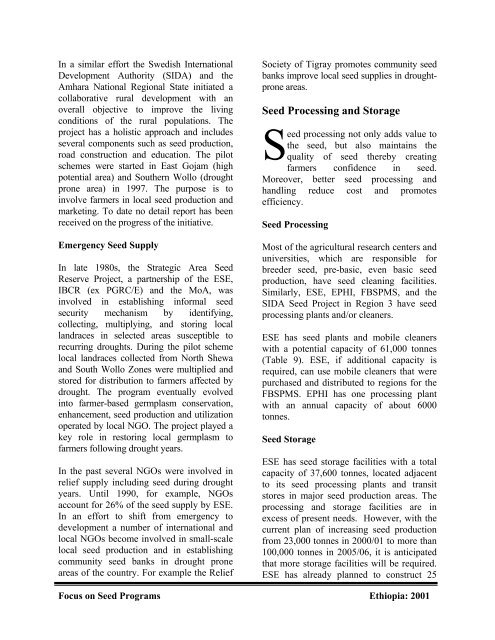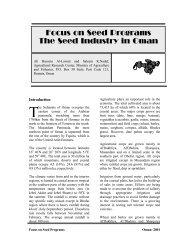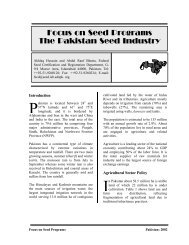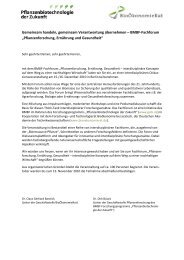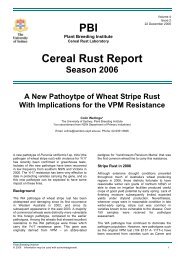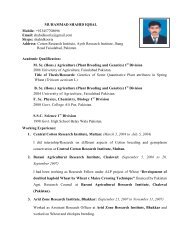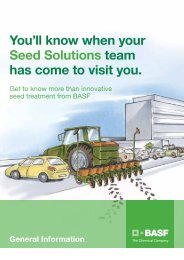The Ethiopian seed industry - SeedQuest
The Ethiopian seed industry - SeedQuest
The Ethiopian seed industry - SeedQuest
Create successful ePaper yourself
Turn your PDF publications into a flip-book with our unique Google optimized e-Paper software.
In a similar effort the Swedish International<br />
Development Authority (SIDA) and the<br />
Amhara National Regional State initiated a<br />
collaborative rural development with an<br />
overall objective to improve the living<br />
conditions of the rural populations. <strong>The</strong><br />
project has a holistic approach and includes<br />
several components such as <strong>seed</strong> production,<br />
road construction and education. <strong>The</strong> pilot<br />
schemes were started in East Gojam (high<br />
potential area) and Southern Wollo (drought<br />
prone area) in 1997. <strong>The</strong> purpose is to<br />
involve farmers in local <strong>seed</strong> production and<br />
marketing. To date no detail report has been<br />
received on the progress of the initiative.<br />
Emergency Seed Supply<br />
In late 1980s, the Strategic Area Seed<br />
Reserve Project, a partnership of the ESE,<br />
IBCR (ex PGRC/E) and the MoA, was<br />
involved in establishing informal <strong>seed</strong><br />
security mechanism by identifying,<br />
collecting, multiplying, and storing local<br />
landraces in selected areas susceptible to<br />
recurring droughts. During the pilot scheme<br />
local landraces collected from North Shewa<br />
and South Wollo Zones were multiplied and<br />
stored for distribution to farmers affected by<br />
drought. <strong>The</strong> program eventually evolved<br />
into farmer-based germplasm conservation,<br />
enhancement, <strong>seed</strong> production and utilization<br />
operated by local NGO. <strong>The</strong> project played a<br />
key role in restoring local germplasm to<br />
farmers following drought years.<br />
In the past several NGOs were involved in<br />
relief supply including <strong>seed</strong> during drought<br />
years. Until 1990, for example, NGOs<br />
account for 26% of the <strong>seed</strong> supply by ESE.<br />
In an effort to shift from emergency to<br />
development a number of international and<br />
local NGOs become involved in small-scale<br />
local <strong>seed</strong> production and in establishing<br />
community <strong>seed</strong> banks in drought prone<br />
areas of the country. For example the Relief<br />
Society of Tigray promotes community <strong>seed</strong><br />
banks improve local <strong>seed</strong> supplies in droughtprone<br />
areas.<br />
Seed Processing and Storage<br />
Seed processing not only adds value to<br />
the <strong>seed</strong>, but also maintains the<br />
quality of <strong>seed</strong> thereby creating<br />
farmers confidence in <strong>seed</strong>.<br />
Moreover, better <strong>seed</strong> processing and<br />
handling reduce cost and promotes<br />
efficiency.<br />
Seed Processing<br />
Most of the agricultural research centers and<br />
universities, which are responsible for<br />
breeder <strong>seed</strong>, pre-basic, even basic <strong>seed</strong><br />
production, have <strong>seed</strong> cleaning facilities.<br />
Similarly, ESE, EPHI, FBSPMS, and the<br />
SIDA Seed Project in Region 3 have <strong>seed</strong><br />
processing plants and/or cleaners.<br />
ESE has <strong>seed</strong> plants and mobile cleaners<br />
with a potential capacity of 61,000 tonnes<br />
(Table 9). ESE, if additional capacity is<br />
required, can use mobile cleaners that were<br />
purchased and distributed to regions for the<br />
FBSPMS. EPHI has one processing plant<br />
with an annual capacity of about 6000<br />
tonnes.<br />
Seed Storage<br />
ESE has <strong>seed</strong> storage facilities with a total<br />
capacity of 37,600 tonnes, located adjacent<br />
to its <strong>seed</strong> processing plants and transit<br />
stores in major <strong>seed</strong> production areas. <strong>The</strong><br />
processing and storage facilities are in<br />
excess of present needs. However, with the<br />
current plan of increasing <strong>seed</strong> production<br />
from 23,000 tonnes in 2000/01 to more than<br />
100,000 tonnes in 2005/06, it is anticipated<br />
that more storage facilities will be required.<br />
ESE has already planned to construct 25<br />
Focus on Seed Programs Ethiopia: 2001


